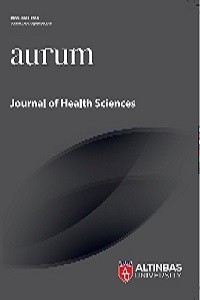Our Clinical Experience in Upper Lumbar Hernia: Retrospective Evaluation of 47 Patients
Our Clinical Experience in Upper Lumbar Hernia: Retrospective Evaluation of 47 Patients
Clinical and radiological examination of upper level lumbar disc hernias (L1-2, L2-3, L3-4) and evaluation of surgical results. 47 patients with upper level lumbar disc hernia (ULLDH) among 282 lumbar disc hernias (LDH) performed in our clinic between April 2015 and April 2017. Age, physical examination, disc distances, radiological findings, preoperative and postoperative findings, complications, recurrence, patient satisfaction were evaluated retrospectively according to Prolo scale (via two 5-point Likert-type scales). Maximum resection principle was applied in the operations. All patients were operated with direct lumbar radiographs and lumbar magnetic resonance imaging (MRI). Lumbar computer tomography and electromyography (EMG) were performed and the diagnoses were supported when necessary. 23 (48.9%) of the cases were male and 24 (51.1%) were female. The average age was 49.9 (25-70). The average period between occurrence of symptoms and attendance to clinic is 3.7 months. The occurrence of L1-2: 3 (6.4%) patients, L2-3: 8 (17%) patients and L3-4: 32 (68.1%) in ULLDH cases (16.6%). Four patients (8.5%) with L2-3 and L3-4 were present. The first operation was not recurred during the 2-year follow-up in our clinic. Spondylodiscitis developed in 1 patient (2.1%) and was improved with medical treatment. In 1 patient (2.1%) preoperative dural injury primer was also repaired. In the early postoperative period, leg pain was disappeared in all cases. According to the Prolo follow-up scale, 31.9% were good and 65.96% were excellent. No bad results had been recorded. The incidence of ULLDH is increasing with the widespread use of MRI. ULLDH, with careful microsurgical technique and maximum disc resection, if operated, surgical success rate increases and complication rate decreases.
Keywords:
Upper, disc, hernia, lumbar microdiscectomy,
___
- Albert, T. J., Balderston, R. A., Heller, J. G., Herkowitz, H. N., Garfin, S. R., Tomany, K., An, H. S., Simeone, F. A. (1993). Upper lumbar disc herniations. J Spinal Disord, 6(4), 351-359.
- Carlson, G., Abitbol, J. J., Garfin, S. R. (1991). Prevention of complications in surgical management of back pain and sciatica. Orthopedics Clinics of North America, 22(2), 345-351.
- Caspar, W., Campbell, B., Barbier, D. D., Kretschmmer, R., Gotfried, Y. (1991). The Caspar microsurgical discectomy and comparison with a conventional standart lumbar disc prosedure. Neurosurgery, 28(1), 78-86.
- Conrad, T., Pappas, E., Harrington, T., Sonntag, H. (1992). Outcome analysis in 654 surgically treated lumbar disc herniations. Neurosurgery, 30(6), 862-866.
- Demirbaş, M. A. (2000). To evaluate the incidence, clinical features, diagnosis and treatment methods in upper-level lumbar disc hernias (Specialization thesis: Haydarpasa Numune Education and Research Hospital).
- Estridge, M. N., Rouke, S. A., Johnston, N. G. (1982). The femoral stretching test. J Neurosurgery, 57, 813-816.
- Eugene, J., Kim, D. H. (1997). A prospective analysis of magnetic resonance imaging findings in patients with sciatica and LDH. Spine, 22(15), 1650-1660.
- Gutterman, P., Shenkin, H. A. (1982). Syndromes associated with protrusion of upper lumbar intervertebral discs. J Neurosurgery, 57, 813-816.
- Hsu, K., Zucherman, J., Shea, W. (1990). High lumbar disc degeneration: incidence and etiology. Spine, 15, 679-682.
- Junge, A., Drovak, J. (1995). Predictors of bad and good outcomes of lumbar disc surgery. Spine, 20(4), 460-468.
- Kostuik, J. P., Harington, J., Alexander, D., Rond, W. (1986). Cauda equina syndrome and lumbar disc herniation. The Journal of Bone and Joint Surgery, 68A(3), 386-390.
- Kotilainen, E., Valtonen, S., Carison, C. A. (1993). Microsurgical treatment of lumbar disc herniation: follow up of 237 patients. Acta Neurochir (Wien), 120, 143-149.
- Nadler, S. F., Campagnolo, D. I., Tomaio, A. C., Stitik, T. P. (1998). High lumbar disc: diagnostic and treatment dilemma. Am J Physical Medicine & Rehabilitation, 77(6), 538-544.
- Paszlar, E., Szervas, I. (1981). Herniation of the upper lumbar discs. Neurosurg Rev, 4(3), 151-157.
- Prolo, D. J., Oklund, S. A., Butcher, M. (1986). Toward uniformity in evaluating results of lumbar spine operations. Spine, 11(6), 601-606.
- Rastecchini, F. (1991). Results of surgery compared with conservative management for lumbar disc herniations. Spine, 21(11), 1383-1387.
- Rogers, L. A. (1988). Experience with limited versus extensive disc removal in patients undergoing microsurgical operations for ruptured lumbar disc. Neurosurgery, 22(1), 82-85.
- Shapiro, S. (1993). Cauda-equina syndrome secondary to lumbar disc herniation. Neurosurgery, 32(5), 743- 746.
- Williams, R. W. (1977). Microdiscectomy-myth, mania or milestone? An 18 years surgical adventure. Adv Neurosurgery, 4, 81- 87.
- Yasuma, T., Arai, K., Yamauchi. Y. (1993). The histology of lumbar intervertebral disc herniations. Spine, 18(13), 1761- 1765.
- Yaşargil, M. G. (1977). Microsurgical operation of the herniated lumbar disc. Adv Neurosurgery, 4, 81- 87.
- ISSN: 2651-2815
- Yayın Aralığı: Yılda 3 Sayı
- Başlangıç: 2018
- Yayıncı: Altınbaş Üniversitesi
Sayıdaki Diğer Makaleler
Chemical Composition of Essential Oil From Aerial Parts of Lactuca serriola L
Our Clinical Experience in Upper Lumbar Hernia: Retrospective Evaluation of 47 Patients
Bleaching of Nonvital Teeth: A Review
BCG Vaccine and New Tuberculosis Vaccines Against Mycobacterium tuberculosis: A review
